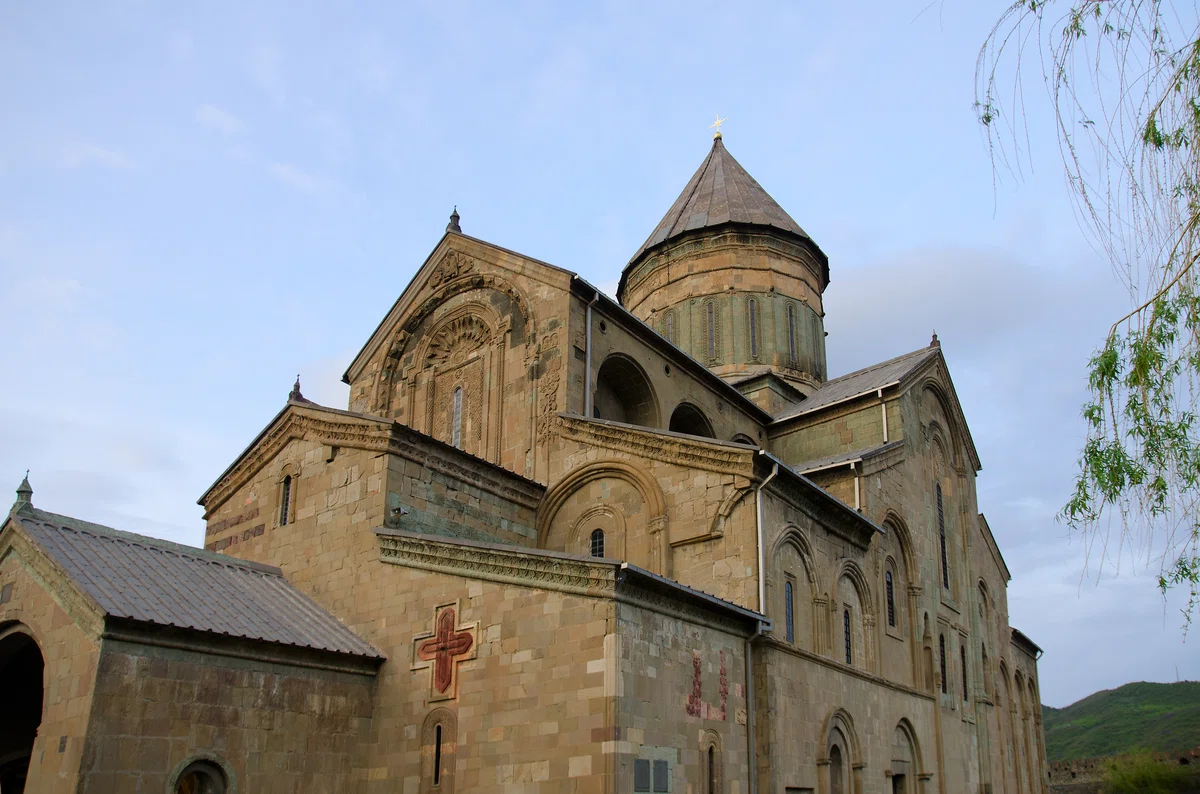
What can the whole family visit? Cultural heritage in the cities of Georgia. Svetitskhoveli Cathedral in Mtskheta. Mikhail Mamulashvili's garden.
Mtskheta today is one of the most visited tourist cities in Georgia. People come here to enjoy the unforgettable atmosphere and ancient architecture, excellent temples. The blog "MadLoba" will tell you more about this wonderful city, show you how much it costs to enter...
Family trip to Mtskheta⬇️
- 1. A real pottery workshop in the ancient city of Mtskheta
- 2. The history of the beautiful city of Mtskheta
- 3. The spread of Christianity in Iberia
- 4. The center of Mtskheta
- 5. Svetitskhoveli Temple — the heart of Mtskheta
- 6. The history of the Svetitskhoveli Temple
- 7. The interior of the temple
- 8. Relics of Svetitskhoveli Cathedral
- 9. Antioch Monastery
- 10. Bebristsikhe Fortress
- 11. The magical place "Mamulashvili Garden"
We arrived in the ancient capital of Georgia Mtskheta. Driving up to the parking lot, we noticed a girl in a red jacket. This girl is a secret photographer who will take pictures of you when you go for a walk in the city. When you return to the car, it will offer you to buy magnets with your image. The approximate cost is 15 GEL.
Our walk around the city began with an antique-styled street. Souvenir shops are located on this street. Here you can buy churchkhela, spices, various souvenirs.
A real pottery workshop in the ancient city of Mtskheta
Walking along the street with souvenir shops, we heard a wonderful ringing similar to the ringing of a bell. A man was playing at one of the pottery shops.
We couldn't pass by, so we decided to come up and express our admiration. This kind man invited us to his pottery workshop.
In the workshop, a master sat at a potter's wheel and worked. A fascinating sight when a new thing is born from a piece of clay before your eyes.
In the workshop there are several potter's wheels and a large kiln for firing finished products. Beautiful clay products are made here: vases, jugs, pots, plates, bowls, toys, souvenirs.
Fedya was allowed to try to work at the potter's wheel. The master started the circle and explained the principle of operation. After some time, with the help of the master, Fedya turned out a wonderful vase.
All clay products, after firing, become very durable. The master has his own recipe for making clay, so all products are of high quality.
Two masters work in the workshop, father and son Eldar and Georgy Mamaladze. Everything they make is patented, starting from the clay recipe, ending with the drawings that the products are painted with.
Eldar Mamaladze graduated from the Academy of Arts in Sukhumi. He worked as an artist for a long time, and then opened his own pottery workshop. He passed his skills to his son George.
Eldar is a very talented person and finally played us two songs "Tbilisi" and the Georgian folk song “Mahevis kalo tinao".
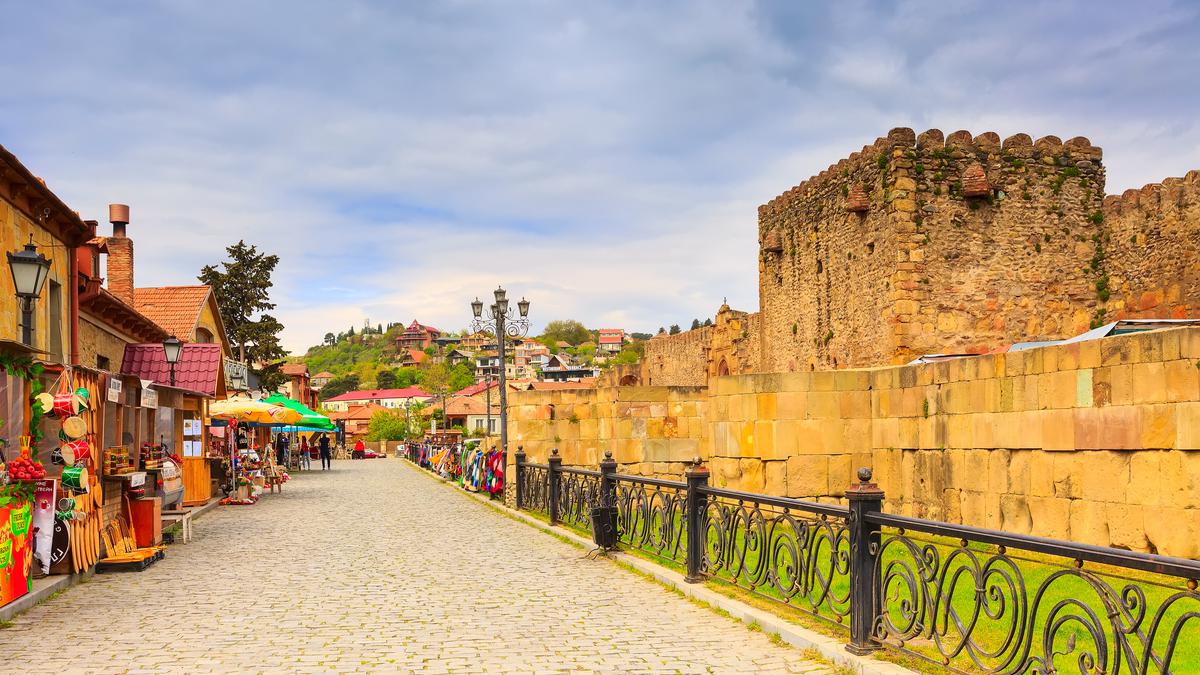
The history of the beautiful city of Mtskheta
Mtskheta was founded in the first millennium BC and was the capital of the ancient eastern Georgian kingdom of Iberia. After the 5th century BC, the capital was moved to Tbilisi.
The old Mtskheta was destroyed by the Arabs in 736 and never fully recovered. For a long time it was actually a village, and it received the status of a city already in the 1950s.
According to legend, the founder of Mtskheta is the legendary Mtskhetos, the son of Kotlas, a descendant of Noah's son Japhet.
Mtskheta is located about 350 kilometers from Mount Ararat, where Noah and his family stopped after the flood.
The city was founded in an incredibly picturesque place, at the confluence of two rivers Aragvi and Kura.
The choice of a place for the ancient capital was not accidental. An exceptionally advantageous strategic position at the confluence of the two most important rivers of eastern Georgia, the Aragvi and the Kura, the possibility of organizing defense, defensive fortifications in the river gorges, close proximity to fertile valleys, which undoubtedly promise economic benefits. All these factors led to the growth and development of the capital of ancient Iberia.
The mountain ranges surrounding Mtskheta were the natural guardians of the capital, closing the approaches to it, but there was also a whole system of defensive structures. The main fortress of the capital was the Acropolis on the right bank of the Kura River, on the top and northern slopes of Mount Bagineti.
Mtskheta controlled the most important ancient trade routes that overlap at the confluence of two rivers. Trade routes connecting eastern countries with the west, passing from the shores of the Caspian Sea to the Black Sea, crossing the Caucasian Ridge and following through the North Caucasus further to Europe.
Caravans loaded with heavy burdens passed at a slow pace along the narrow, cobbled streets of the capital, along the cobblestones polished for centuries. And the silence of the sultry streets was broken by the guttural cries of the drivers or the ringing of bells on the necks of pack animals. Merchants with oriental goods were coming, carrying incense, luxurious silks, precious stones from distant countries, they were heading west. When the caravan stopped, crowded fairs gathered.
Mtskheta is a developed, densely populated city, the capital of Kartli, the residence of the tsar and the highest state authority. A city where Jews, Greeks, Syrians, Persians and other Eastern nationalities lived next to Georgians. There were five languages in ancient Kartli: Greek, Hebrew, Syriac, Armenian and Khazar.
Idols, polychrome statues of gods, visible from afar, were placed on a high mountain, towering over the ancient capital. Gold, silver, and precious stones were used to make these sculptures. The existence of sculptures made of precious materials in the ancient capital of Georgia, which make a strong impression on contemporaries, speaks of the high art of ancient masters, the strength of their talent.
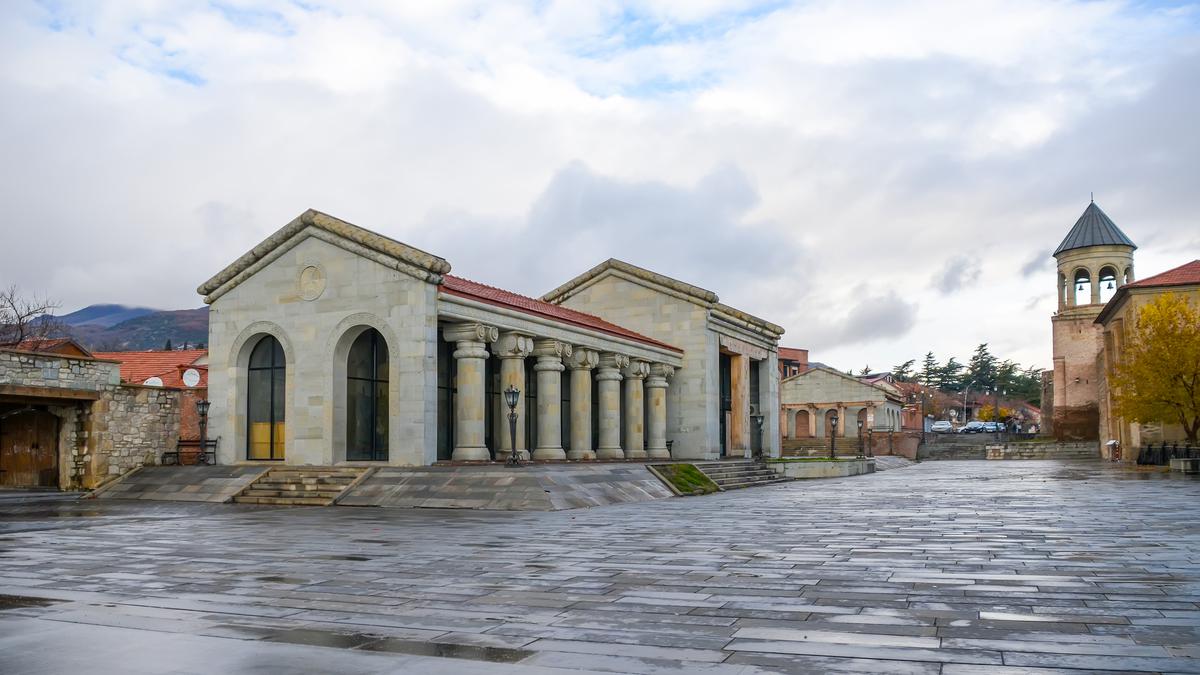
The spread of Christianity in Iberia
The spread of Christianity in Iberia is associated with the name of a Christian girl Nino from Cappadocia.
Persecuted for her faith, Nino
traveled a long way from Jerusalem to Georgia, through Javakheti, southern Georgia, she came to Iberia and, passing the ancient city of Urbnisi, came to Mtskheta.
Being present at the pagan idols festival in Armazi, she offered up a prayer to her god, and a hurricane of destructive force threw the idols she hated from their pedestals, smashed them to smithereens. Then she found refuge in the house of the caretaker of the royal garden. She lived here for six years, gaining recognition for her sermons and her ability to heal.
Queen Nana fell seriously ill and no human art could cure her. Nino of Cappadocia healed the hopelessly ill queen and converted her to Christianity. King Mirian still remained faithful to the ancient religion, although Nino had already instilled doubts in him.
One case was enough, and the king stopped hesitating. On a hot July day, King Mirian was hunting with his retinue in the forest, on Mount Thoti, and suddenly the sun faded over him, and it became dark as night. The hunters have lost their way. King Mirian appealed to his pagan gods in vain, the darkness did not dissipate. Having lost hope of salvation, remembering Nino's sermons, the king offered prayers to her god, and the darkness dispersed, and the sun shone. Returning safely home, Tsar Nino called to him and converted to Christianity. By order of the tsar, residents of Mtskheta were baptized, and preachers of the new faith were sent throughout the country to convert the entire population of the country.
Mtskheta is the most popular tourist city in Georgia.
During the reign of King Mirian in 334 AD, Georgia adopted Christianity. The tsar ordered to demolish the old pagan temples and build Christian ones. Two Mtskheta pearls were laid under him: the Svetitskhoveli Temple and Samtavro.
Today Mtskheta is one of the most popular tourist destinations in all of Georgia. There is no such cluster of cathedrals, monasteries, fortresses and ruins of ancient cities anywhere else in Georgia.
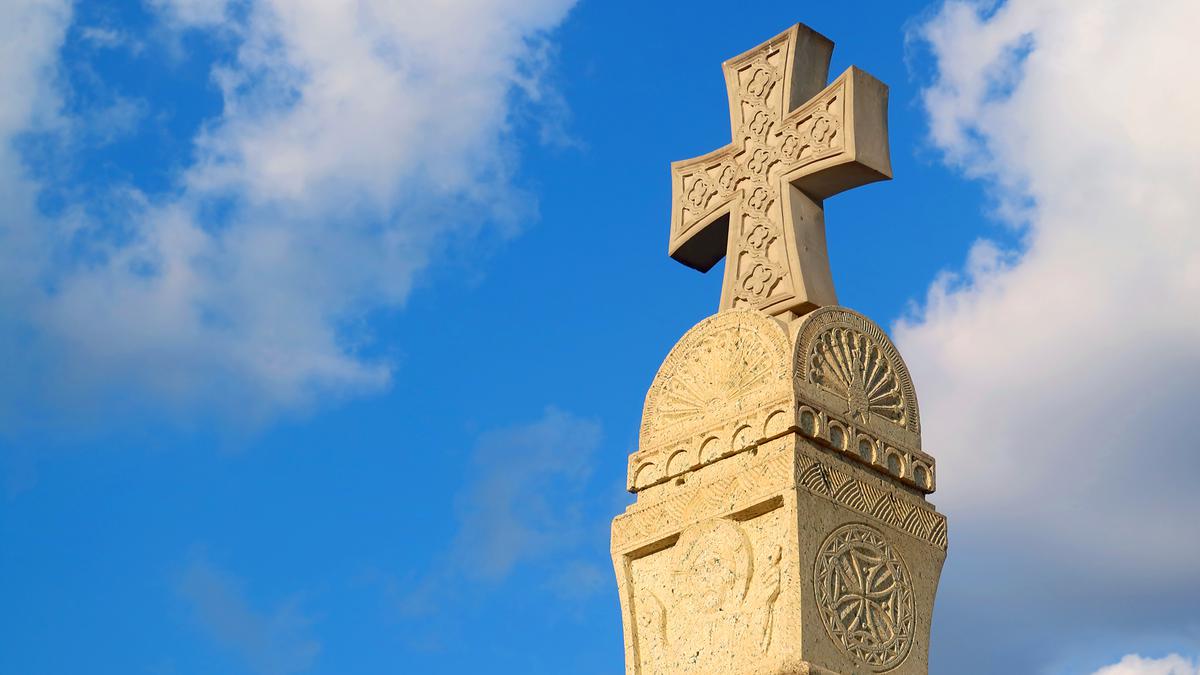
The center of Mtskheta
It is difficult to call the city center historical, it is rather stylized, restored. There are very few antiquities left in the city: Svetitskhoveli Cathedral, Samtavro Monastery, Antioch Church and several archaeological sites, including the picturesque ruins of the Bebristsikhe fortress.
Everything else is restoration. One of the first global projects of the new Georgian leadership aimed at developing the country's tourism potential.
A kilometer from the cathedral, the city looks more like a Soviet district center than the former capital of one of the first Christian states.
The city center is quite compact, traditional Georgian building. The closer to Svetitskhoveli, the greater the percentage of old buildings and the more well-maintained they are. There is nothing at the Samtavro level anymore, only five-story buildings. Therefore, it is more interesting to walk around the center.
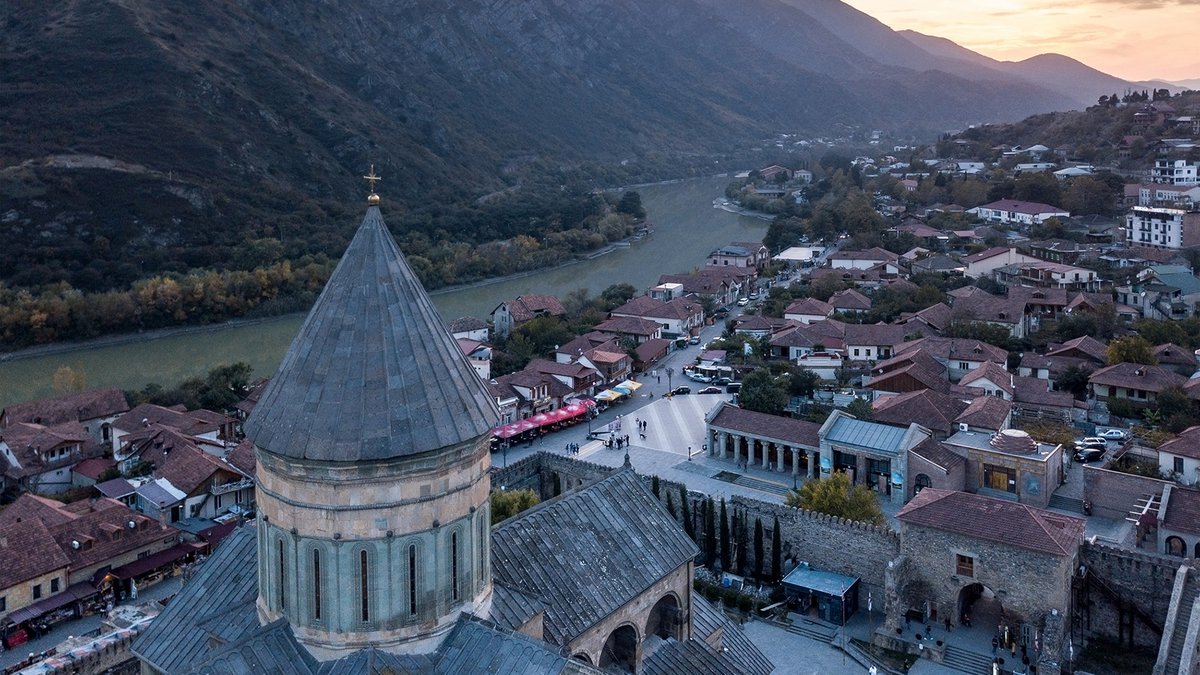
Svetitskhoveli Temple — the heart of Mtskheta
Svetitskhoveli Cathedral, one of the most revered places of the Georgian Orthodox Church. Georgian tsars were crowned here, and the enthronement ceremony of the Catholicos is still taking place here.
The church on this site has existed since the fourth century, but the existing building was built from 1010 to 1029. The fence, taller than a man, was added in 1787, so that a large courtyard turned out.
The cathedral is made in the traditions of Georgian architecture. It was built as a cross-domed temple with a round drum at the top.
The temple has two official names “Cathedral in the name of the Twelve Apostles” and “Svetitskhoveli”, “Sveti” is a pillar, and “Tskhoveli" is alive or miraculous.
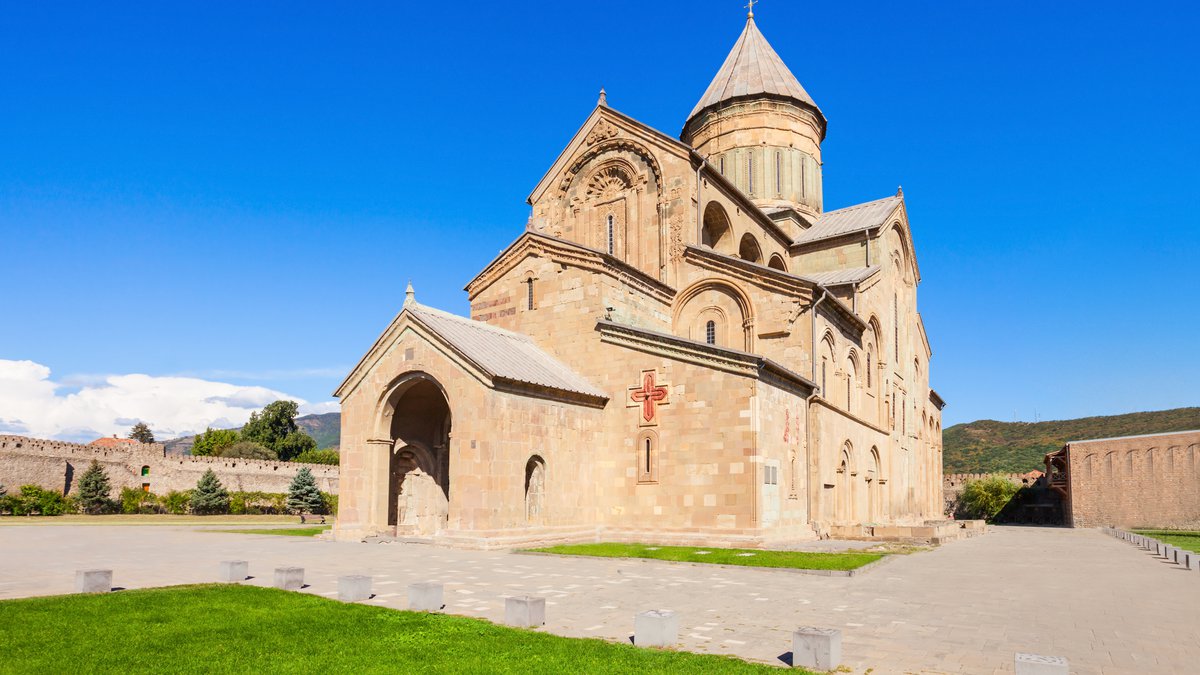
The history of the Svetitskhoveli Temple
It is believed that the chiton of Jesus Christ was buried in the ground in this place and subsequently a cedar grew here, which became a sacred tree for local residents. In the fourth century, the royal palace stood nearby, and a cedar tree grew in the garden of this palace. When Saint Nino came to Georgia, she lived in the gardener's house near this garden. There she was visited by some visions, which were interpreted to her as follows: “Your vision means that this garden will turn through you into a garden of exaltation of God, to whom glory belongs now and ever and for ever and ever.”
When King Mirian decided to be baptized, the question arose about the place of construction of the first temple. Before the arrival of the priests from Greece, after the tsar and all the people had zealously embarked on the path of Christianity, the tsar had a conversation with Nino about building a church. The believing tsar asked Saint Nino, “Where can I build a house for God?”, and Nino replied, “Wherever the king's mind will be,” and the king said, ”I love this your blackberry bush and I wish there according to my understanding. But no, I will not spare the royal garden and the height of the cedars, the abundance of foliage and the fragrance of flowers. In it I will build a temple of prayer for myself, which will stand forever.”
The cedar was cut down, a pillar was made of it, but they could not put it in place with their hands. A little later, he established himself in some miraculous way.
This plot is sometimes displayed in the iconography of our time. The image of Georgian saints and the pillar itself in the center can be found in almost every temple.
In the V century, Tsar Vakhtang Gorgasali established the Catholicosate, moved the chair of the Mtskheta Bishopric of Yesitiskoveli to Samtavro, and Svetitskhoveli became the chair of the Catholicos, on this occasion Vakhtang built a basilica here.
In the 1970s - 71s, restoration was carried out, as a result of which the foundation of the fifth-century basilica was opened.
In the temple you can notice stone bull heads — these are the remains of the same basilica of the V century. It is possible that there are many more such fragments in the temple, but archaeologists do not yet have a consensus on this issue.
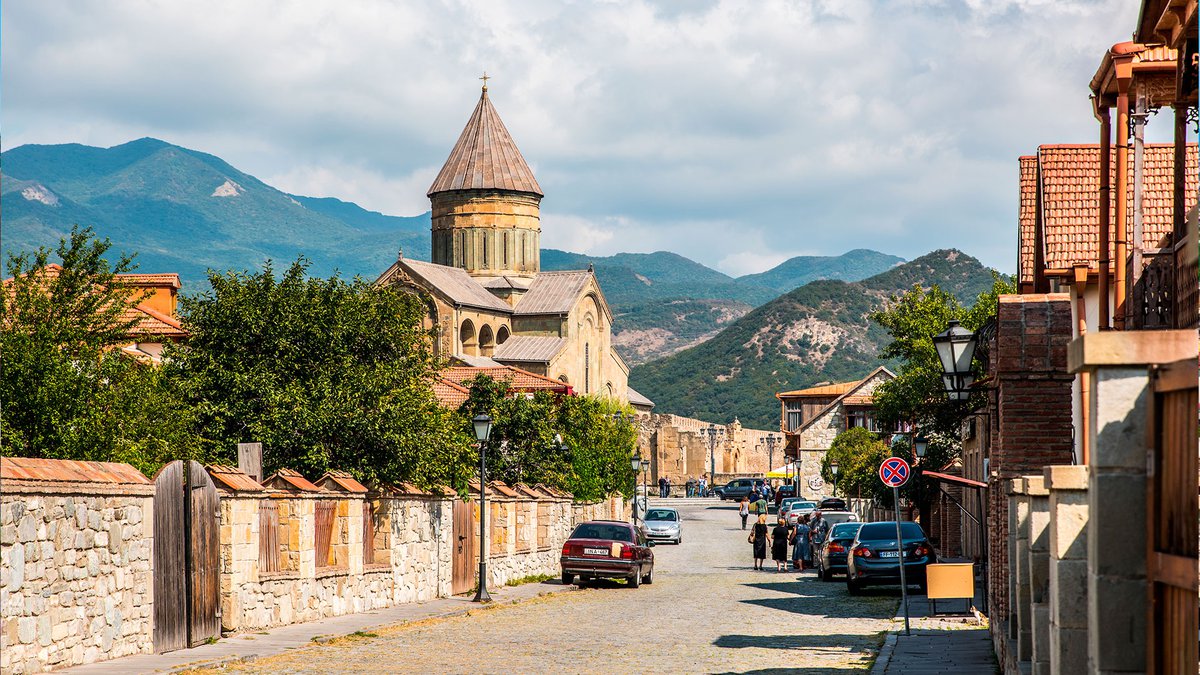
The interior of the temple
Now there are eight supporting pillars in the temple, four of them are domed. The stone throne of the patriarch is attached to the third right pillar. It appeared and was painted in the XV century with frescoes in the Persian style. Now it is not used as a throne.
The life-giving pillar in Svetitskhoveli.
The main thing inside the temple is the life—giving pillar. It is located approximately in the center of the temple, on the site of the third left column. A low marble side is now laid out around the pillar, covered with inscriptions in asomtavruli font.
The history of its origin.
The temple was built on the place where the sacred cedar grew, the cedar was cut down and turned into a column, which was installed directly on its own stump. Further, this column ceased to be a supporting column and turned into a free-standing pillar.
A stone canopy was built over the pillar, in the XV century it was surrounded by a high stone wall and it turned, in fact, into a stone tower. In the same century, this tower was painted with frescoes that illustrate the history of the chiton and the pillar itself.
Three sides of the pillar are painted:
From the west — scenes of the resurrection of the crucifixion.
From the south and east — the scenes of the installation of the pillar
There are no frescoes on the north side, the Trinity icon used to hang there, and in 2017 Christ Pantocrator was hanged. At the base, on the north side, there is a niche with doors, where there was a place to take the world flowing out of the pillar. The myrrh flow stopped after the invasion of Shah Abbas I.
The most interesting thing on the western wall is that it is divided into four sections. In the upper right there is a crucifixion, on both sides of the crucifix we see something resembling jellyfish, red and white or gray. Since the 1980s, there have been rumors that these are flying saucers.
Indeed, it looks a bit like flying jellyfish, although in fact it is a visualization of the biblical phrase “The sun will turn into darkness and the moon into blood when the great and glorious day of the Lord comes.” So that the red medusa is the blood moon, although it may be a very subtle reference to the prophet Isaiah: “And the moon will blush and the sun will be ashamed when the Lord of Hosts reigns on Mount Seon and in Jerusalem.”
We study further. In addition to the frescoes on the Life-Giving Pillar, there are also frescoes on the walls and pillars. Where the scenes of the apocalypse, the intriguing zodiac circle, the famous etishovetsky jellyfish and much more are depicted.
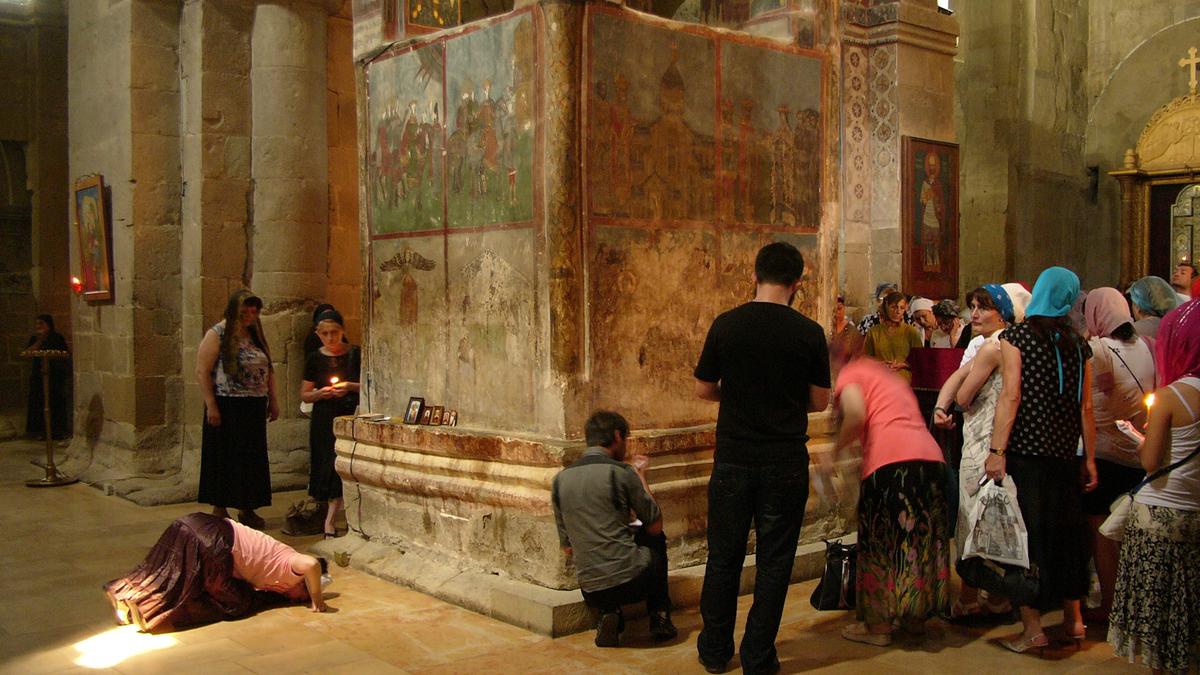
Fresco depicting the scene of the "Last Judgment".
The greatest interest is usually caused by the fresco of the southern wall, where the scene of the "Last Judgment" is painted.
In the Bible, this scene is mentioned by the prophet Ezekiel in the apocalypse, strictly speaking, this is not the last judgment, but the second coming.
There are few such frescoes in the world, it is commonly thought that they began to appear in the 14th or 15th centuries, in the era of fascination with mysticism.
According to another version, their appearance is associated with a change in the format of the liturgy, when the apocalypse began to be read out at the service.
The central place in this fresco is occupied by the figure of Christ surrounded by angels and the zodiac circle. Angels are often mistaken for the figures of the apostles, although these are angels with wings and there are not twelve, but ten, plus cherubim and thrones.
The fresco depicts Christ on a throne with the Gospel in his left hand. The gospel looks like a scroll with text.
Behind Christ, the red rhombus is a symbol of the earth, the red color symbolizes the earth, and the rhombus represents the four cardinal directions. Inside the diamond, you can see the red wings — these are thrones, angels of the highest hierarchy. In Georgia they are called Sakdari, they are usually painted translucent, but here they are red. Four figures are visible from the outside of the diamond: an eagle, a bull, a lion and a man — this is a reference to the visions from the fourth chapter of the apocalypse:
“There are four animals around the throne, full of eyes both in front and behind. And the first animal was like a lion, and the second animal was like a calf, and the third animal had a face like a man, and the fourth animal was like a flying eagle.” All these figures are inscribed in a circle with the Greek text from the first verses of the 148th psalm. This circular inscription is very important, it explains the meaning of the image. Around this inscription, it is the mentioned angels, the sun, the moon and the stars who praise the Lord. Then another outer circle, divided into 13 sections. There are ten angels, two cherubs and two wheels at the very bottom.
The angel at the very top is the Archangel Michael, who is recognized by the white circle in his left hand. It is a symbol of foresight. He is the main one in the angelic hierarchy, therefore, from above. It is difficult to establish the names of the other angels, since there is a lot of systematization of angels in the tradition and we will no longer know which one the artists adhered to. The two wheels at the bottom of the angelic circle are also thrones. These are the wheels from Ezekiel's vision, they are almost always visible in the image of Christ Pantocrator. Around the angels are 12 zodiac signs, stars, sun and moon. It is probably a symbol of the universe or even of the heavenly host, to which stars were sometimes attributed, and sometimes angels. It seems to hint at the power of Christ over the physical part of the universe.
These symbols of constellations often cause embarrassment to viewers due to dubious associations with astrology, but in Georgia of those years astrology hardly existed. So these are probably just astronomical symbols.
The zodiac of Svetitskhoveli is probably the most famous, although not the only one.There are many more things drawn around the main circle with angels. This is probably the scene “The Earth and the Sea give up their dead". Usually such scenes were drawn not according to the Bible, but according to the work of Ephraim the Syrian, the word for the second coming of our Lord Jesus Christ. And everything is so symbolized there that it is almost impossible to decipher the meaning of the image.
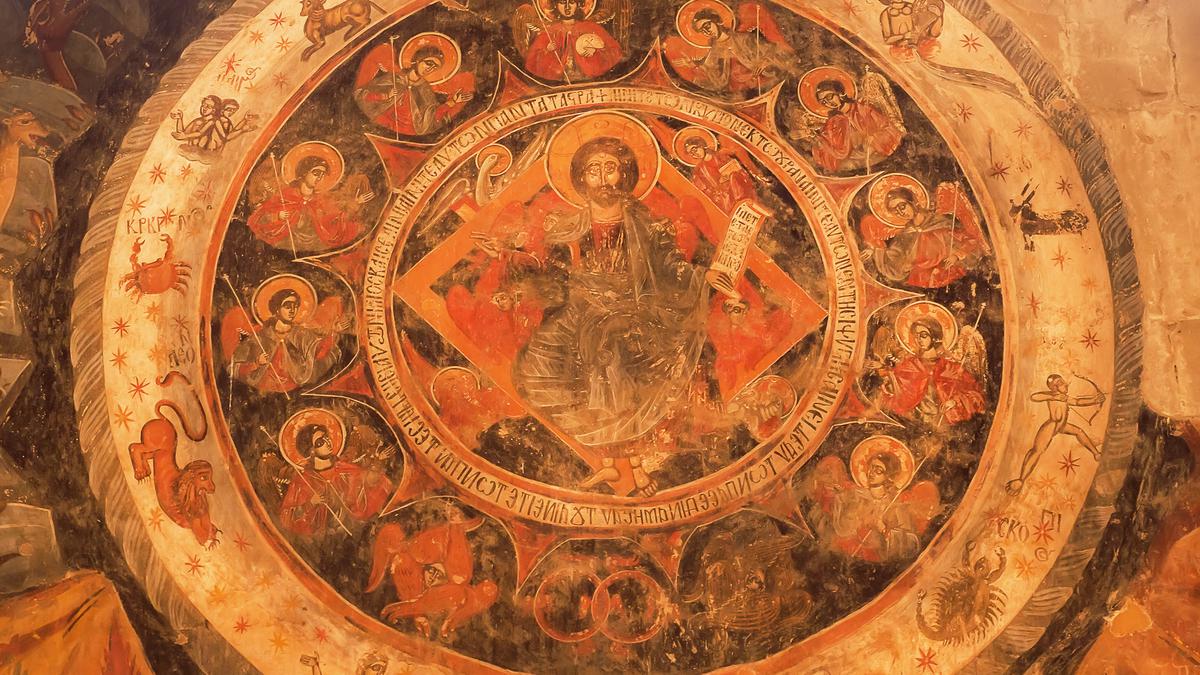
A little bit about the dome.
Ezekiel's vision clearly haunted the authors of the Svetitskhovey frescoes. They simplistically repeated it in the painting of the dome, which was preserved rather poorly. It also depicts Christ Pantocrator, the figure of the beast Tetramorph and wheels with Cherubs.
Altar niche.
For the third time, Christ Pantocrator is depicted in the altar niche. This is the largest and most prominent figure in the temple. Jesus holds the Gospel in his left hand, and the gesture of his right hand is sometimes interpreted as a blessing, but sometimes as a gesture calling for silence. And in this fresco we see wheels again, and even with tongues of flame. This is already a direct reference to the aforementioned fragment from the prophet Daniel. The mural looks good, but it's mostly a 19th-century restoration.
The throne of the patriarch.
Frescoes are also painted on the stone throne of the patriarch at the far right column. This is a good example of late Georgian painting. Instead of grape leaves, as was customary before the 15th century, we see abstract golden lines, clearly borrowed from Persian culture.
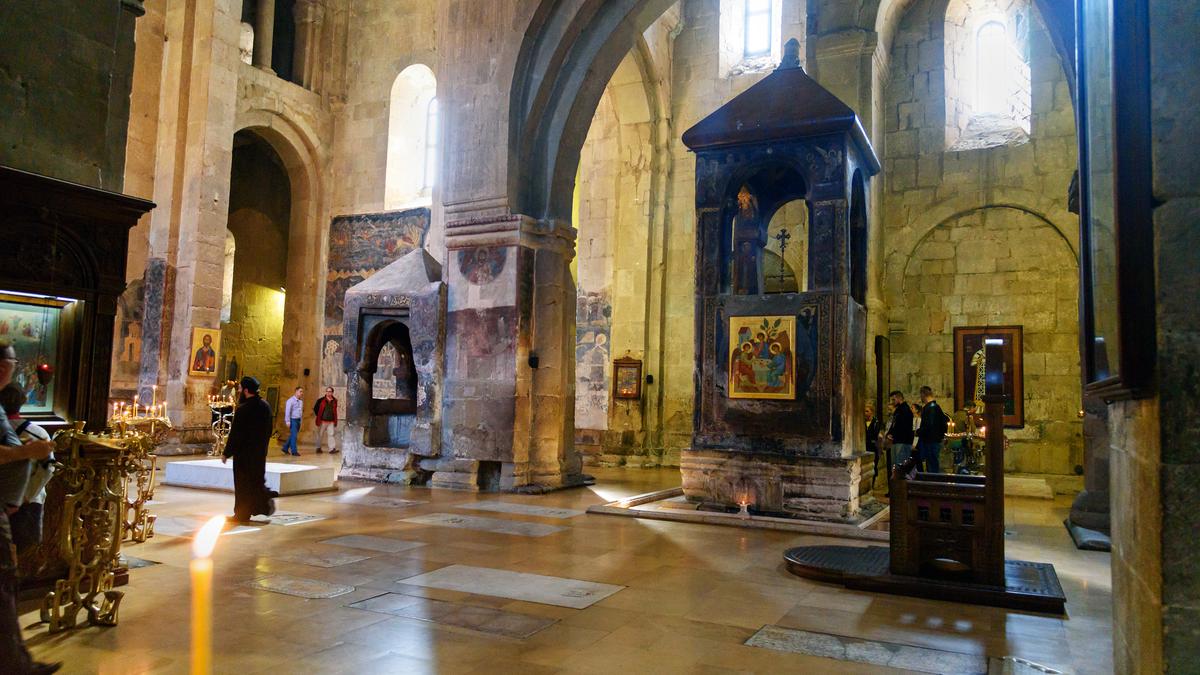
A fresco depicting Queen Mariam.
The most interesting thing next to the throne is the figure of a woman with a boy depicted on a pillar.
This is Mariam Dadiani and her son Otia. She was the sister of Prince Levan II of Mingrelia, the wife of Simon Gurieli, then King Rostom and finally King Vakhtang V. She was buried in this cathedral sometime between 1680 and 1684.
This fresco is interesting in Persian style. It shows how far Georgian painting has gone from Byzantine standards by the end of the 17th century.
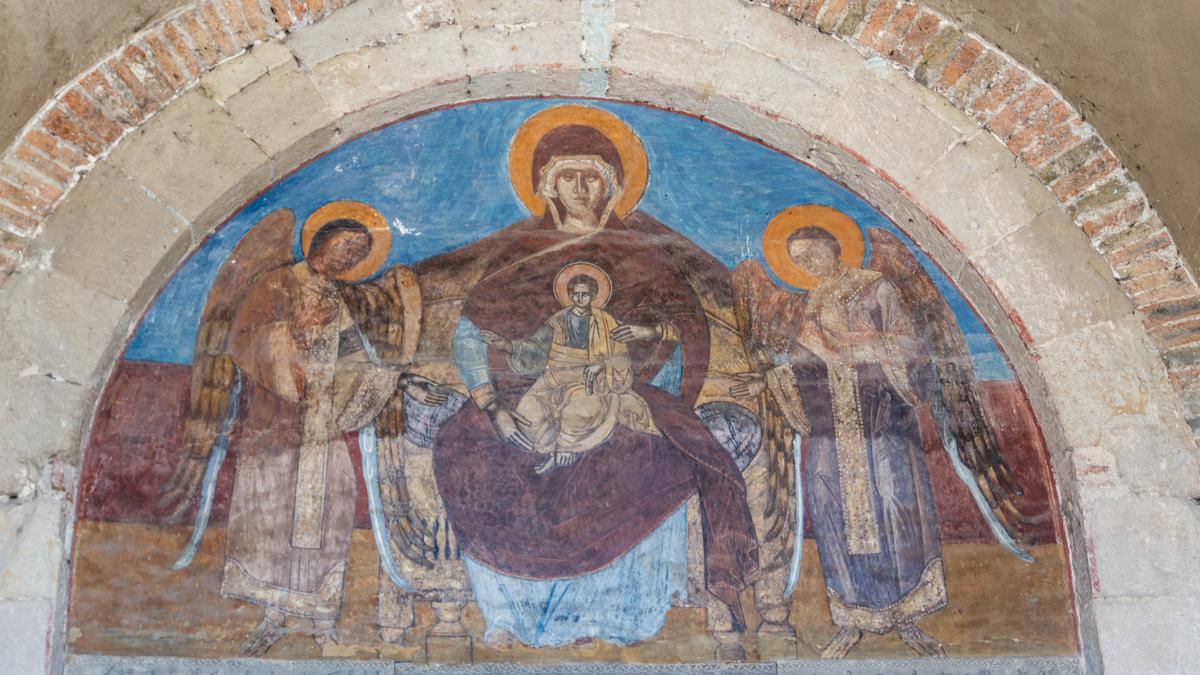
A fresco depicting St. Christopher.
This is a rare fresco. Traditionally, Christopher is painted with the head of a dog. According to legend, Roman legionaries captured him in Libya. After that, he served as a legionnaire himself for a while. He was big, strong and quite scary in appearance. The dog's head is either a metaphor for his ugliness, or a metaphor for his Libyan origin.
In Russia in 1722 it was forbidden to depict Christopher in this form in order to avoid insinuations. Many of the images were destroyed, only a few remained. After the annexation of Georgia to Russia, this fresco also had chances to die, but somehow it was forgotten about.
Christopher's name is based on a legend according to which he decided to benefit humanity by carrying people across the river. One day he had to carry a baby, which turned out to be incredibly heavy. Then he was informed that this is Christ, who bears the sins of the whole world. Thus arose the name of the Christ-Bearer.
The fresco is located on the second left column, on its eastern side.
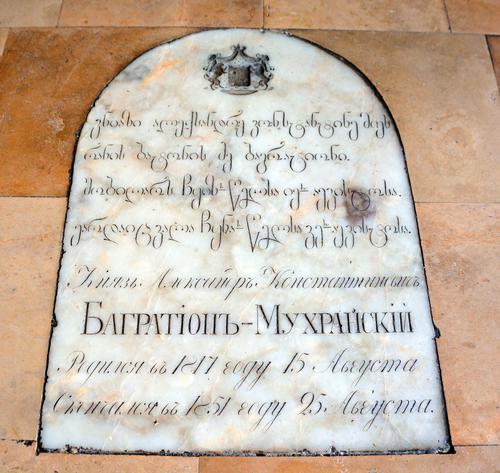
Burials in the Svetitskhoveli Temple.
In the previous era, the temple was a necropolis and almost all Georgian kings were buried here, starting from the twelfth century. But very little remains of the royal burials. Now you can see here:
- graves of King Heraclius II, black slab with shield and sword;
- King Vakhtang Gorgasali;
- Tsar George XII;
- tsarevna Tekna;
- there are many graves of the Bagration-Mukhrani princes.
To the north of the tombstone of Tsar George XII, there is a black slab, the tombstone of his wife, and a little further there is another black slab with the inscription “Peter Bagration-Georgian".
Peter Petrovich Gruzinsky, until 1984 — the head of the Georgian royal family and the author of two famous songs “Tbilisi” and “Chito-grito".
After the death of Queen Tamara, her body was in Svetitskhoveli for some time, then it was buried in Gelati. According to the chronicles, many more kings were buried here, but their tombstones have not been preserved.
The tombstone of Heraclius II is indirectly mentioned by Lermontov in the poem ”Mtsyri”, where there is such a passage: “They sweep away the dust from the tombstones, which the inscription says how dejected with his crown, such and such a tsar, in such and such a year, handed his people to Russia.”
The biographical data of the life of Heraclius II could only be written in one place, on his own plate. The tradition of verbose inscriptions on slabs really existed at that time. There are such plates in the cathedral.
Now the slab on the grave of Irakli is already different. Apparently it was replaced in Soviet times. The mention of the tombstone is another argument in favor of the version that Lermontov's poem describes the Svetitskhoveli monastery.
Tombstone of Queen Tamara.
Near the slab of George XII, to the west of it, there is another tombstone made of white marble with an inscription in Georgian and Arabic. This is the first wife of Tsar George XI Tamara Bagration-Davitashvili, who died in 1684. The Arabic text on this plate is an abridged translation of the Georgian text. The Georgian text is written in asomtavruli font, in the abbreviation can be read in various ways. But the content is something like this: “When I took power in our kingdom, George, the son of Tsar Shanovaz, in the fifth year of our reign, an epidemic overtook us and Queen Tamara disappeared from our eyes and we were left in sorrow. We placed her in our crypt and put this marble on her grave. Whoever read this, forgive her. If someone king or someone noble removes it or opens the grave, for our sins, let him be called to account on the day of the Last Judgment.”
The strangeness of this plate is that it is duplicated in Arabic, although in the 17th century Persian was the second language in Georgia. It is believed that this is a consequence of a certain cultural connection with the Christian communities of the Middle East, and it also helped to more accurately date the first year of the reign of George XI.
Interestingly, the burial is located at the entrance to the porticos of the cathedral. There is no tombstone itself, but there is an inscription on the right on the wall. This is a message about the death of Catholicos Domentius III in 1676.
Relics of Svetitskhoveli Cathedral
The chiton of Christ.
The cathedral contains quite important relics, the main one is the chiton of Christ, which, according to legend, are still in the ground, in the grave of Sidonia, that is, strictly under the tower with the pillar.
This is not entirely consistent with the chronicle tradition, which says that the chiton was buried not exactly in this place, but somewhere near.
The cape of the Prophet Elijah.
The cathedral should contain the cloak of the prophet Elijah, which he left to the prophet Elisha during his ascension to heaven. This scene is described in the second chapter of the fourth book of kings, “When they were walking and talking on the way, suddenly a chariot of fire and horses of fire appeared, and separated them both, and Elijah rushed into heaven like a whirlwind. But Elisha looked and exclaimed, “My father! My father! The chariot of Israel and its cavalry.” And I never saw him again. And he seized his clothes and tore them in two. And he picked up the mantle of Elijah that had fallen from him, and went back, and stood on the bank of the Jordan.”
A bas-relief depicting this scene is located on the entrance doors of the temple.
They write that the milot is kept behind the altar, but whether anyone has seen it is not known.
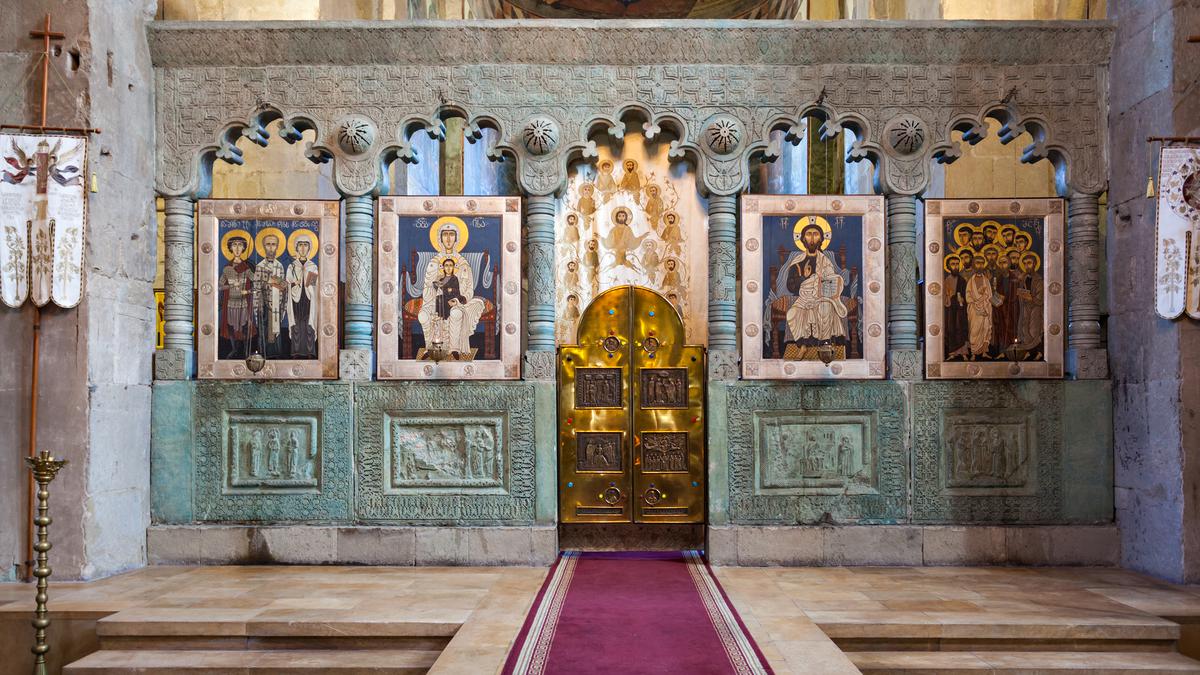
A wooden cross with a particle of the True Cross.
On the north wall there is now a large wooden cross with enamel decorations. A particle of the true cross is inserted into the lower part of the cross. Legend says that this part of the cross was presented to the Georgian community by Emperor Constantine. As we know, the cross was found by Empress Elena and divided into two parts, the Jerusalem and Constantinople. The last part was then divided into two parts again. Probably, this is the half of the Constantinople part that was transferred personally to Constantine. We know that Constantine received several nails of the cross, and we know from tradition that Georgia received a part of the cross with nails. This coincidence is an argument in favor of the version.
I don't know if the cross particle has passed the authenticity examination, but the examination of the other parts recently showed that they all represent a tree of the same breed — an olive.
A particle of the power of St. Andrew the First-Called.
In the left aisle of the temple, in its left wall there is a niche where there is a wooden model of a human foot, and a particle of the relics of St. Andrew is inserted into it.
Also in the cathedral you can see a list from the ancient icon of the Mother of God of Tsilkan.
Chapel in the Svetitskhoveli Temple.
A chapel was built into the south nave in the 13th or 14th century. There may be an illusion that this is something ancient, but in fact it is rather an imitation of the Temple of the Resurrection. There is a Baptistery here. To the right of the entrance is the Baptistery, in which, according to legend, King Mirian himself was baptized. This is a functioning font.
If you go a little further from the Baptistery, you can find yourself near the chapel, a symbolic copy of the Holy Sepulchre.
A well with holy water.
In the left aisle of the cathedral there is a well with holy water. However, it is not allowed to take water without a blessing. In the center of the interior there is a carved throne for the patriarch. On the iconostasis of the central aisle there is an icon of the "Presentation of the Lord".
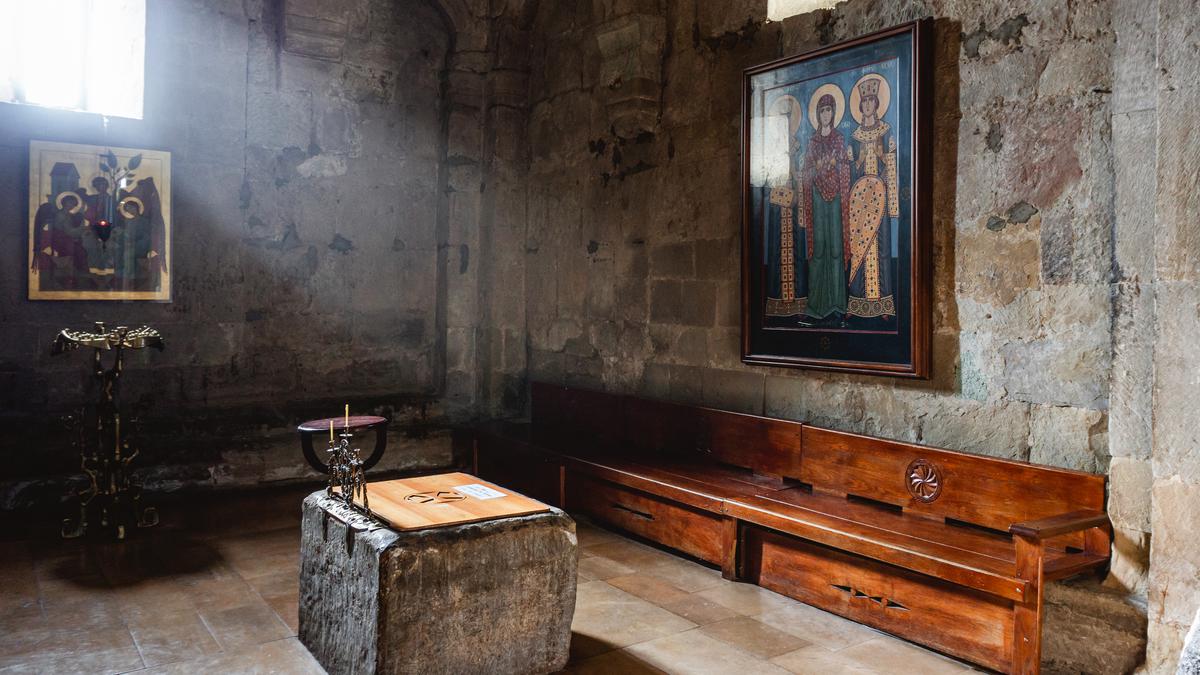
Antioch Monastery
Then we went to the small monastery of Antioch. Unfortunately, almost nothing is known about him. This is a tiny convent, which is officially called the monastery of "Stephen the First Martyr", and informally — Antioch.
If you go straight from the main square of Mtskheta along souvenir street, then it will lead to this place.
The monastery was built in the 4th or 5th century, but, unfortunately, it was severely destroyed during the Arab invasion of 735 and restored only in the later centuries. There are stone fragments from the early epochs, and brick fragments from the later ones.
Unfortunately, there are no stories connected with this temple, it just exists. Nothing more can be said about him. It makes sense to pay attention to the stones on the south side. This is clearly a former cemetery of the ancient era. There are even fragments of stone coffins, as in the Samtavr burial ground.
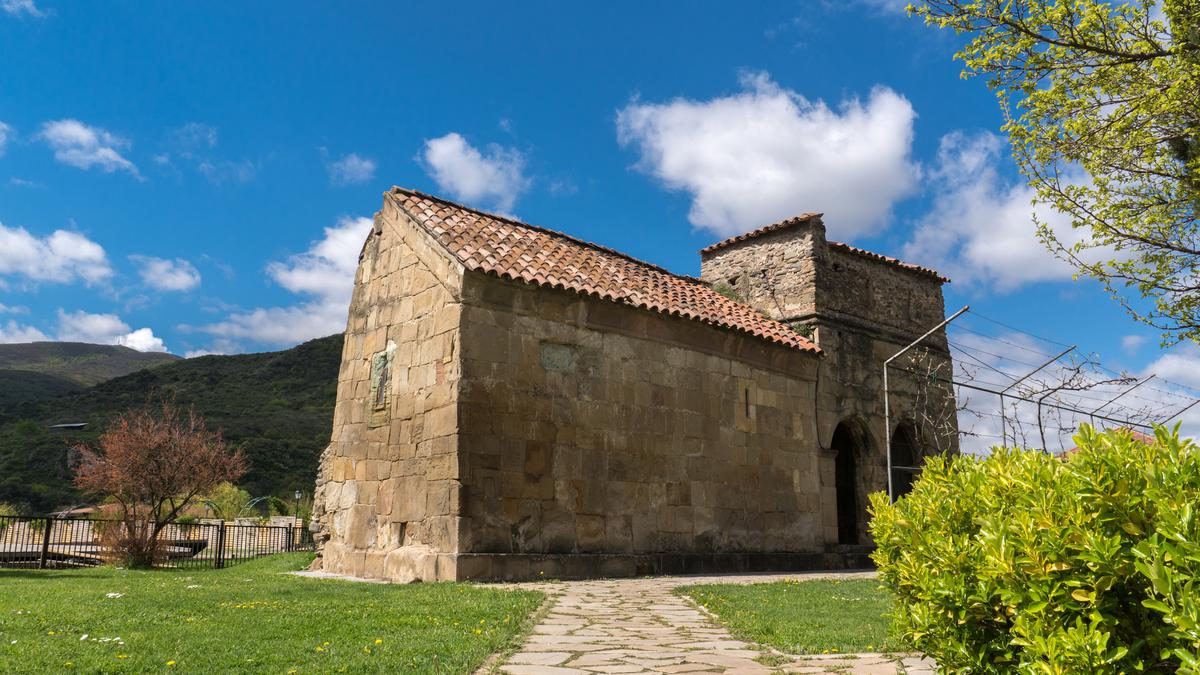
Bebristsikhe Fortress
After Antioch, we head to the fortress of Bebristsikhe. The fortress stands right next to the highway that leads from Mtskheta to the north.
Bebristsikhe Fortress is located on a steep cliff, on the right bank of the Aragvi River.
To date, part of the tower, the western wall and individual elements of the fortifications have been preserved on the territory. The fortress once played the role of a defender of Mtskheta from the north. At the place where the fortress is located, the gorge is very narrow, this played a very important role from the point of view of defense.
Numerous finds made during the archaeological excavations carried out in 2006-2008 showed that Bebristsikhe was an active fortress from the 4th to the 18th century.
Specialists of the National Agency for the Protection of Cultural Heritage Monuments of Georgia have begun to restore the north-eastern tower of the ancient fortress, restoration work is currently underway here.
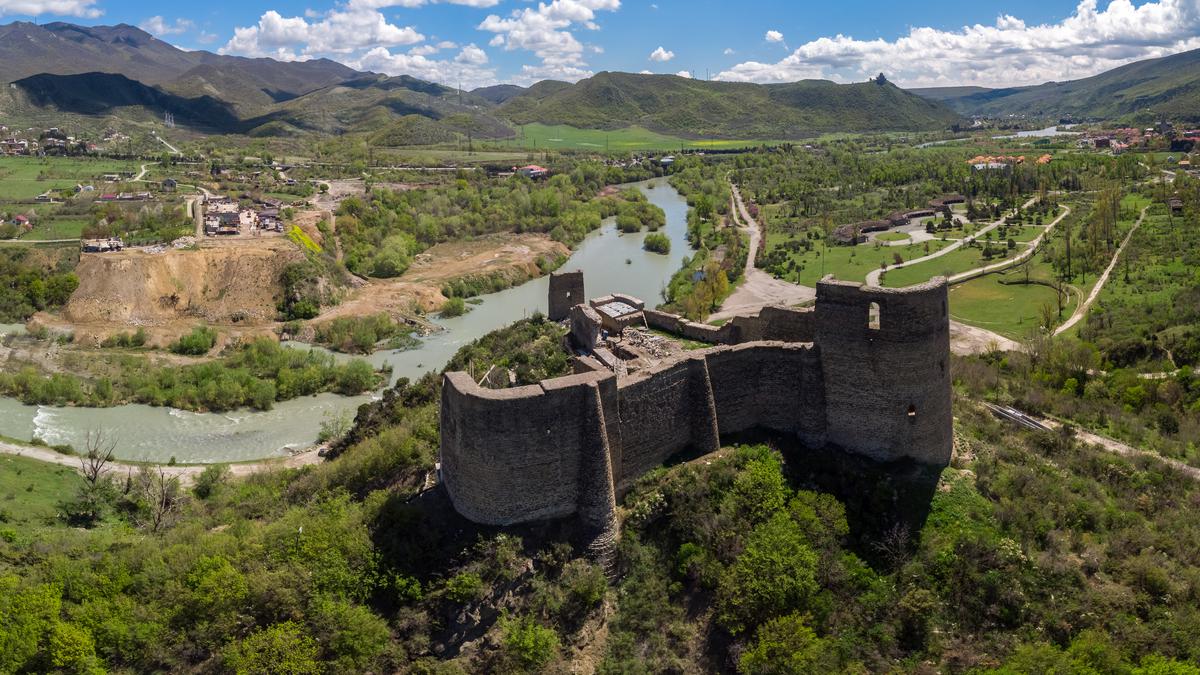
The magical place "Mamulashvili Garden"
Then we visited a magical place called “Mamulashvili Garden”, this garden is about 150 years old.
Why is it magical? But how else to name the corner in which the wizard lived and worked.
He was born in 1873 and lived for almost 100 years. The name of this wizard is Mikhail Mamulashvili, a famous decorator and honored artist.
Mikhail himself said that once in his youth he entered the university, but failed the exam. Upset, he was walking home and stumbled over a stone, picked it up and thought, “I will prove that I am not an empty person, I will take and grow a flower on this stone.” That's how it all started. Mamulashvili created an example of landscape art on the infield. Decorative corners were created from discarded material, discarded pottery, broken bowls, huge boulders, volcanic rocks, smooth with recesses where moss or cacti could be placed. He found the stones himself or was brought to him from different places, for example, from the banks of the Kura, Aragvi, even from Mount Mashuk. He loved to weave baskets, and he also decorated them with moss and flowers.
In the garden there were roses, more than a hundred varieties, as well as carnations, lilies and tulips. He brought out several varieties of roses himself. He took care of the garden himself, then his daughter Pelagia, who received guests and tourists, took them around the garden and literally could read a whole lecture about each plant.
In 1959, a small film about Mamulashvili was even made at the Tbilisi Film Studio, called “Sapovnela”, which means a flower that no one can find.
Passing through the garden gate, you seem to get into another world. The garden is not so big, but suddenly it turns out to be a whole universe, which has no boundaries. Here, a huge tree with the difficult-to-pronounce name “Ginkgo Biloba” stands proudly above the roof of a dilapidated house. Here, on large stones, you can see small copies of the Mtskheta temple, paths, tiny stairs carved in stone. Such toys and warm, coming from somewhere from childhood. The compositions of flowers and stones are already overgrown with moss, and in some places with weeds, but they still keep the order that the master's hand once gave them.
Mamulashvili died in 1973 and is buried in his front garden.
Nowadays the garden is being restored. Since this is a private property, it is not easy to get into the garden, if it is closed, you can knock and you will most likely be invited.
That's how interesting our walk around Mtskheta was. If you want to learn more about Georgia, subscribe to our channel "Georgia one hundred questions".
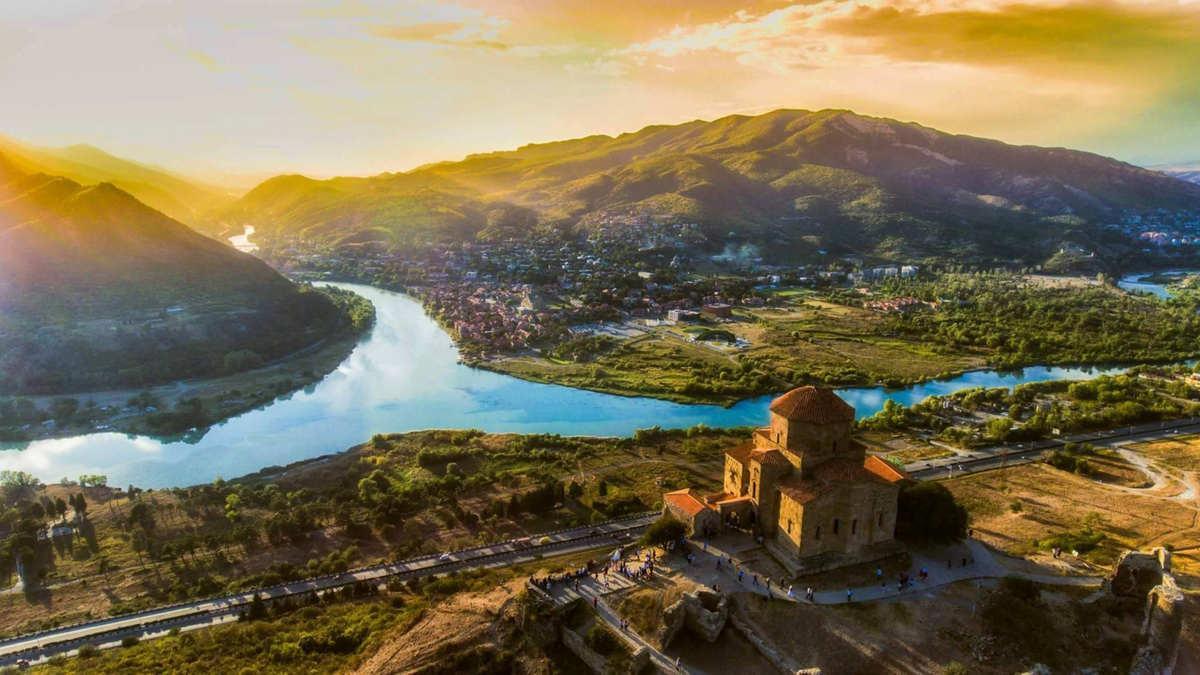


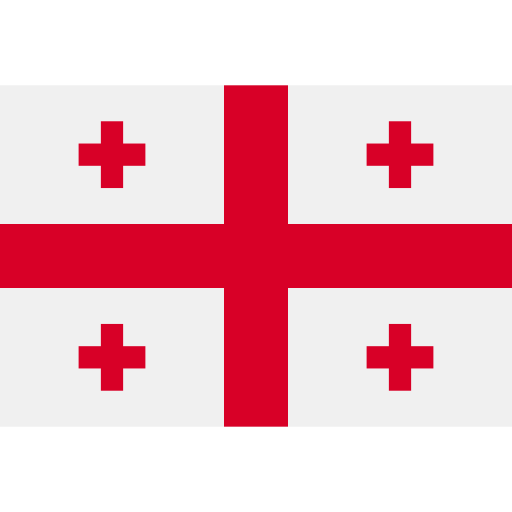

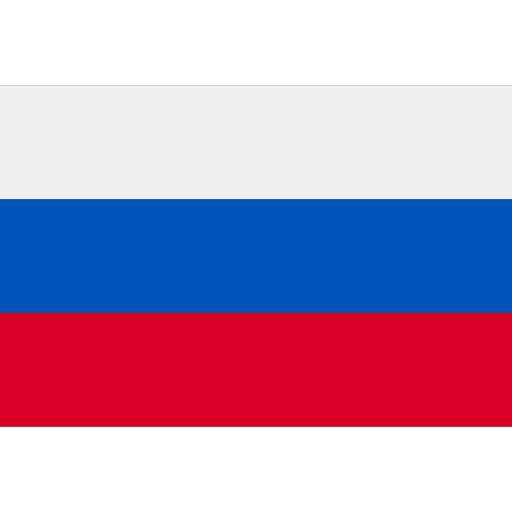
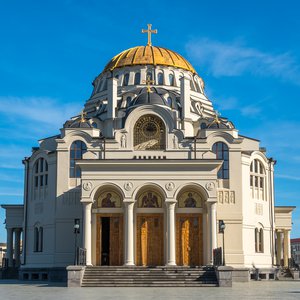
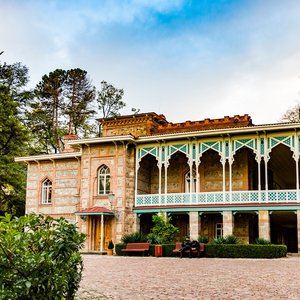






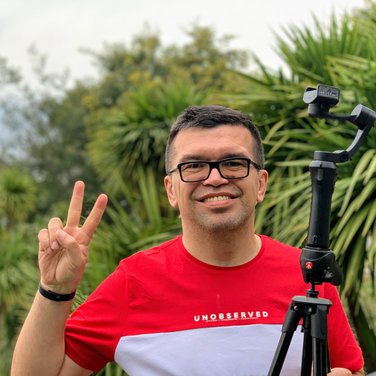
3 comments
Log in to leave a comment
Также было очень увлекательно смотреть как делают чашку из глины. Я бы тоже такую хотела бы попробовать сделать такую чашку.